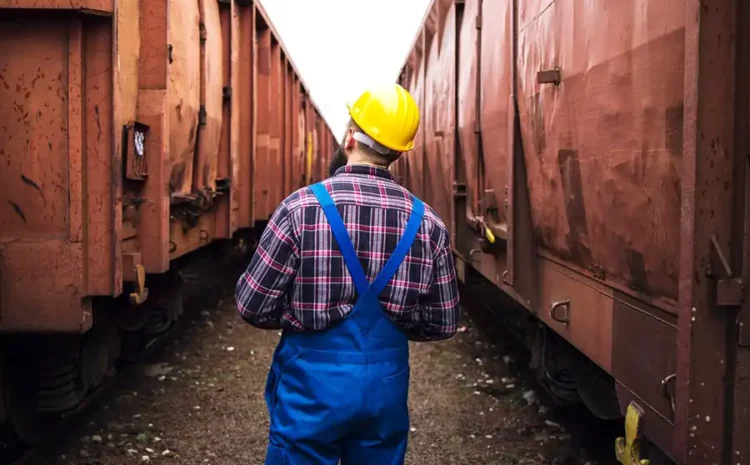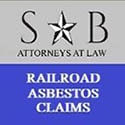
Asbestos exposure has been a critical health issue affecting countless individuals, particularly those in industries where asbestos-containing materials (ACMs) were commonly used. Among the most affected are railroad workers, who have historically faced significant risks due to the widespread use of asbestos in various components of trains and railroad infrastructure. Sammons & Berry P.C. is dedicated to helping these workers seek justice and compensation for their exposure. In this blog post, we will explore the myriad ways railroad workers were exposed to asbestos, the health implications, and the legal avenues available for affected individuals.
The Prevalence of Asbestos in the Railroad Industry
Historical Use of Asbestos
Asbestos, a naturally occurring mineral known for its heat resistance and insulating properties, was widely used in the railroad industry throughout the 20th century. Its popularity stemmed from its affordability and effectiveness in preventing heat and fire damage, making it an ideal material for various applications in locomotives and train cars.
Key Uses of Asbestos in Railroads:
- Insulation: Asbestos was extensively used as insulation in boilers, pipes, and other components that generated heat. This application was crucial for preventing overheating and ensuring the safe operation of train engines, making it an indispensable part of locomotive engineering during its time.
- Brake Pads and Linings: Asbestos fibers were woven into brake pads and linings due to their durability and heat resistance. These materials were chosen specifically because they could withstand the friction and heat generated during braking, reducing wear and tear.
- Gaskets and Seals: Asbestos-containing gaskets and seals were utilized to withstand high temperatures and prevent leaks. They were often found in engines and other mechanical components, where they provided a crucial barrier against heat and fluids.
- Flooring and Ceiling Materials: Train interiors often included asbestos-laden materials for fireproofing and soundproofing. These materials were favored not only for their protective qualities but also for enhancing passenger comfort.
Extent of Exposure
Railroad workers were exposed to asbestos through various means, often unknowingly, as they performed their daily tasks. From maintenance crews to engineers, the risk of inhaling or coming into contact with asbestos fibers was omnipresent.
Common Roles at Risk:
- Engineers and Conductors: Operated trains where asbestos was present in brakes, insulation, and other components. These workers were often in close quarters with asbestos-laden materials, increasing their exposure risk.
- Maintenance Workers: Repaired and maintained trains and tracks, often disturbing asbestos-containing materials. Tasks like cutting, drilling, or sanding could release asbestos fibers into the air, making these roles particularly hazardous.
- Construction Workers: Built and renovated railway stations and infrastructure that included asbestos products. These workers were frequently exposed to dust and debris, especially during demolition or remodeling projects.
- Manufacturing Workers: Involved in the production of train parts and materials containing asbestos. Exposure could occur during the handling of raw materials or the assembly of components.
Specific Areas of Asbestos Exposure in Railroads
Locomotives and Train Cars
Insulation: The primary source of asbestos exposure in locomotives was insulation around boilers, pipes, and electrical components. Workers handling these areas were at high risk, especially during repairs or dismantling. Even routine inspections could expose workers to airborne fibers.
Brake Systems: Asbestos brake pads and linings were common until the late 20th century. Mechanics and maintenance workers faced significant exposure when replacing or repairing these components, often without adequate protective gear.
Flooring and Interior Panels: Asbestos was used in the flooring, walls, and ceilings of train cars for its soundproofing and fire-retardant qualities. Construction and renovation projects frequently released asbestos fibers into the air, endangering anyone working nearby.
Rail Yards and Workshops
Repair Shops: Asbestos exposure was prevalent in workshops where old locomotives and cars were repaired or dismantled. Grinding, cutting, or sanding of asbestos materials released dangerous fibers. These environments often lacked proper ventilation, compounding the risk.
Machinery Maintenance: Workers servicing heavy machinery used in rail yards often dealt with asbestos-containing gaskets and seals, posing inhalation risks during maintenance activities. Even seemingly minor repairs could disturb asbestos fibers and put workers at risk.
Railway Stations and Buildings
Construction Materials: Many railway stations were built with asbestos-containing materials, including roof shingles, tiles, and insulation. Workers involved in construction, renovation, or demolition of these buildings were at risk, often unaware of the hidden dangers.
HVAC Systems: Asbestos was used in heating, ventilation, and air conditioning systems within railway stations, posing risks to maintenance staff handling these systems. The deterioration of these systems over time could lead to increased exposure.
Health Implications of Asbestos Exposure
Understanding Asbestos-Related Diseases
Exposure to asbestos fibers can lead to several severe health conditions, often manifesting years or even decades after initial exposure. The latency period makes early detection and treatment challenging.
Common Asbestos-Related Diseases:
- Mesothelioma: A rare and aggressive cancer affecting the lining of the lungs, abdomen, or heart. Mesothelioma is almost exclusively linked to asbestos exposure and can take up to 50 years to develop after exposure.
- Lung Cancer: Asbestos exposure increases the risk of lung cancer, particularly among smokers. This type of cancer can also take decades to manifest.
- Throat Cancer: Cancer that can develop in the throat due to prolonged asbestos exposure. Symptoms may include persistent sore throat and difficulty swallowing.
- Esophageal Cancer: Cancer of the esophagus that has been linked to asbestos exposure. It can cause symptoms such as chest pain and difficulty swallowing.
- Stomach Cancer: Prolonged exposure to asbestos may increase the risk of stomach cancer. Symptoms may include abdominal pain and weight loss.
- Colon Cancer: Asbestos exposure has also been linked to colon cancer, with symptoms like changes in bowel habits and abdominal discomfort.
- Asbestosis: A chronic lung condition caused by inhaling asbestos fibers, leading to lung scarring and breathing difficulties. This non-cancerous condition can severely impact the quality of life.
- Pleural Plaques: Thickened areas on the lining of the lungs or diaphragm, often indicating previous asbestos exposure but not necessarily harmful themselves. They serve as a marker of asbestos exposure and potential future health risks.
These cancers and conditions can take decades to develop, with symptoms often appearing 20 to 50 years after exposure. The long latency period makes early diagnosis and treatment particularly challenging for affected individuals, emphasizing the importance of regular medical check-ups for those with known asbestos exposure.
Symptoms and Diagnosis
Symptoms of asbestos-related diseases can vary depending on the condition but often include:
- Persistent cough
- Shortness of breath
- Chest pain
- Fatigue and weight loss
- Difficulty swallowing
Diagnosis typically involves imaging tests such as X-rays or CT scans, along with biopsies to confirm the presence of asbestos fibers in the body. Early detection is crucial for improving treatment outcomes, making awareness and education about these symptoms vital for at-risk individuals.
Legal Rights and Compensation for Railroad Workers
Understanding Legal Options
Railroad workers diagnosed with asbestos-related diseases may be entitled to compensation through various legal avenues. Sammons & Berry P.C. specializes in helping clients navigate these complex legal processes to secure justice and financial support.
Potential Legal Claims:
- Personal Injury Claims: Individuals suffering from asbestos-related illnesses can file personal injury lawsuits against manufacturers of asbestos-containing products or employers who failed to provide a safe working environment. These claims can cover medical expenses, lost wages, and other damages.
- Wrongful Death Claims: Families of deceased workers can pursue wrongful death claims to seek compensation for their loved one’s suffering and lost income. These claims can provide financial support to families who have lost a primary breadwinner.
- Trust Fund Claims: Many asbestos companies have established trust funds to compensate victims. Eligible individuals can file claims with these trusts to receive compensation. These funds offer a streamlined process for obtaining financial relief.
How Sammons & Berry P.C. Can Help
Sammons & Berry P.C. offers extensive experience in handling asbestos-related cases, particularly for railroad workers. Their dedicated team understands the unique challenges these cases present and works tirelessly to achieve favorable outcomes for clients.
Firm Highlights:
- Proven Track Record: Successfully secured significant settlements and verdicts for asbestos victims. Their expertise ensures that clients receive the best possible legal representation.
- Client-Centered Approach: Focused on providing personalized legal strategies tailored to each client’s needs. Sammons & Berry P.C. prioritizes clear communication and compassionate support throughout the legal process.
- Comprehensive Support: Assists clients with medical evaluations, claim filings, and court proceedings. Their holistic approach addresses both legal and practical needs, offering peace of mind to affected individuals and their families.
Steps to Take If You Suspect Asbestos Exposure
For railroad workers concerned about potential asbestos exposure, taking immediate action is crucial to protect their health and legal rights.
Recommended Actions:
- Seek Medical Evaluation: Consult a healthcare professional to assess any symptoms and determine if asbestos exposure may be a factor. Early medical intervention can significantly impact treatment success.
- Document Work History: Gather records of employment, job roles, and any specific incidents of potential asbestos exposure. Detailed documentation can strengthen legal claims and facilitate compensation.
- Consult Legal Experts: Contact experienced asbestos attorneys, like Sammons & Berry P.C., to explore legal options and understand your rights. Professional legal guidance can help navigate the complexities of asbestos litigation.
Asbestos exposure remains a significant concern for many railroad workers, posing severe health risks and legal challenges. Understanding the sources of exposure, recognizing symptoms of asbestos-related diseases, and seeking legal assistance are vital steps in addressing this issue. Sammons & Berry P.C. stands ready to support affected individuals and their families, offering expert legal guidance to secure the compensation and justice they deserve. If you or a loved one has been impacted by asbestos exposure in the railroad industry, don’t hesitate to reach out for professional help. The journey toward justice and recovery begins with awareness and action.
See if you qualify for compensation
Sammons & Berry, P.C.
800-519-1440
View our Google Listing
View our Facebook


